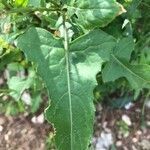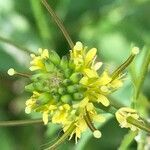Annuals; glabrous or pubescent. Stems erect, unbranched or branched distally, (1-)2-6(-8) dm, glabrous or sparsely pilose at least basally, usually glabrous distally. Basal leaves (soon withered); not rosulate; petiole (0.5-)1-4(-6) cm; blade broadly ovate to obovate or broadly oblanceolate, 2-8(-10) cm × 10-30(-50) mm, margins lyrate-pinnatipartite; lobes 2-4 on each side, oblong or lanceolate, smaller than terminal lobe, margins subentire or dentate, (terminal lobe ovate, margins dentate). Cauline leaves similar to basal, (distalmost with shorter petiole); blade smaller, margins dentate, lobes 1-3 on each side. Fruiting pedicels divaricate, stout, nearly as wide as fruit, 1-2(-3) mm, (pilose adaxially). Flowers: sepals ascending, oblong, 1.5-2(-2.5) × 0.8-1.5 mm; petals pale spatulate, 1.4-2(-2.5) × 0.2-0.5 mm, claw ca. 0.5 mm; filaments 1.7-2.5(-3) mm; anthers ovate, 0.1-0.2 mm. Fruits narrowly linear, straight, obscurely torulose, stout, (1.7-)2-4.5(-5.2) cm × 0.9-1.2 mm; valves glabrous; ovules 30-46(-54) per ovary; style (slender) 0.5-1(-2) mm; stigma prominently 2-lobed. Seeds 0.9-1.3 × 0.4-0.6 mm. 2n = 14.
Annual herb 10–80 cm high, erect, glabrous or shortly pubescent. Leaves lyrate-pinnatifid, petiolate, serrate, reducing in size up stem, sometimes ovate-lanceolate, rarely entire. Sepals 1–2 mm long, glabrous. Petals 1–2.5 mm long, pale yellow. Style less than 1 mm long. Siliqua 25–50 mm long, 1 mm wide, attenuate to style; pedicels stout, horizontal, 2–5 mm long. Seeds ovoid, c. 1 mm long.


